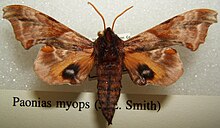Paonias myops
| Paonias myops | ||||||||||||
|---|---|---|---|---|---|---|---|---|---|---|---|---|

Paonias myops |
||||||||||||
| Systematics | ||||||||||||
|
||||||||||||
| Scientific name | ||||||||||||
| Paonias myops | ||||||||||||
| ( JE Smith , 1797) |
Paonias myops is a butterfly ( moth ) from the family of moth (Sphingidae).
features
butterfly
The moths have a fore wing length of 22 to 38 millimeters. They can be distinguished from the other species of the genus Paonias mainly by the outer edge of the forewings. In Paonias myops , the outer edge of the forewings is fairly even, with arches near the apex and anal angle. In Paonias astylus it is fairly straight, in Paonias excaecata it is strongly wavy over the entire length.
The basic color of the forewings can vary from very light brown to dark chocolate brown. The corrugation of the outer edge of the forewings can also be more pronounced or very weak. The degree of yellowing on the hind wings is also variable.
Caterpillar
The caterpillars are light lime green in the last stage and are heavily covered with pale, yellowish setae , which make the body surface appear very coarse. The animals have seven yellow, diagonal stripes on each side of their body. The first six are faint and can be very pale. The last strip that goes to the anal horn is strong and fat. Many animals are heavily covered with bright red spots that are outlined in yellow. This gives the caterpillars a great resemblance to similar spots on ripe cherry tree leaves. The amount and location of these spots varies greatly from person to person.
Doll
The pupa is chestnut brown to dark purple, almost black in color. It has a grainy surface. The doll is often slightly indented in places along the abdomen. The proboscis is fused with the body. The cremaster is short, thin, and ends in a fairly sharp point.
Occurrence
The species occurs from Nova Scotia and Maine to south Florida and west to British Columbia, Washington, California and Arizona and also south to Mexico. It occurs in the majority of its range together with Paonias excaecata . The differences are that Paonias myops does not occur so far north in eastern and western Canada, whereas the species inhabits the Great Basin and southeastern Arizona, where Paonias excaecata does not occur. In contrast to Paonias excaecata , Paonias myops is absent on the Pacific coast .
The animals, like Paonias excaecata, are widespread in the deciduous forests of the USA and Canada. In the Great Plains they are also tied to watercourses with vegetation of willow and rose plants .
Way of life
The proboscis of the adults is very short so that they cannot take in any food. At night they fly to artificial light sources.
The species occurs in the north of its range in midsummer. Most of the evidence comes from mid-June to mid-July. Further south, the moths fly much longer, so it stands to reason that several generations may occur. In Louisiana, the species flies mostly from March to September. In the mountainous regions of the southwest, however, the species seems to occur again in only one generation per year, depending on the altitude.
Food of the caterpillars
The caterpillars feed on the rose family (Rosaceae), in particular on Prunus species.
development
The females lay their eggs one by one on the underside of the leaves of the host plants. The caterpillars are solitary and rest along the midrib on the underside of the leaves. Pupation takes place in a chamber in the ground.
supporting documents
Individual evidence
- ↑ a b c d e f g h i j James P. Tuttle: The Hawkmoths of North America, A Natural History Study of the Sphingidae of the United States and Canada. The Wedge Entomological Research Foundation, Washington, DC 2007, ISBN 978-0-9796633-0-7 , pp. 121f.
- ^ Attributes of Paonias myops. Butterflies and Moths of North America, accessed June 17, 2015 .
literature
- James P. Tuttle: The Hawkmoths of North America, A Natural History Study of the Sphingidae of the United States and Canada. The Wedge Entomological Research Foundation, Washington, DC 2007, ISBN 978-0-9796633-0-7 .
